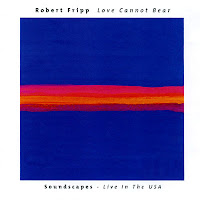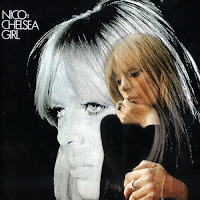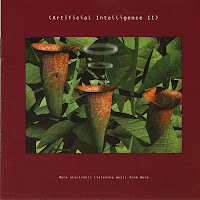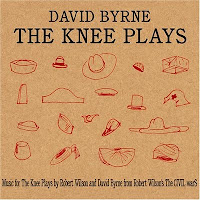I have a habit of repeating myself throughout this blog, so apologies for that. One such thing I often find myself saying is how much Robert Fripp redefined the way I listen to guitar music. His Love Cannot Bear: Soundscapes – Live In The USA is a good example of this. Fripp, the backbone of the band King Crimson has, over time, developed techniques that allow his guitar to trigger electronic sounds – often dubbed Frippertronics – from a bank of equipment which fully disguises the fact that a guitar prompted the sound that emerges. The result is a serene suite of electronic atmospherics which allowed me in the past to bridge the gap between the apparently limitless possibilities of the synth and the enduring versatility of the humble electric guitar.

Fripp frequently played on records produced by Brian Eno, and the two have collaborated on a number of influential duo albums. Eno’s Desert Island Selection, a companion CD album to the vinyl More Blank Than Frank comprises tracks culled from his back catalogue and sees Eno’s progression from post-Roxy glam oddness on Here Come The Warm Jets to the pioneering ambience of Music For Airports. I already own More Blank Than Frank on vinyl, which I bought many years ago in Barcelona. I’d like to say that I was in the city on some sort of Hemingway-inspired bohemian backpacking expedition, but I wasn’t. Regrettably, whilst there’s a bit of cross-over between the two albums, the best track on More Blank Than Frank – ‘King’s Lead Hat’, an anagram of Talking Heads, who Eno produced – is absent here. ‘I’ll Come Running (To Tie Your Shoe)’ and ‘Here He Comes’, close second and third are here however.

One of the defining artistic collaborations Eno developed was with David Bowie, who began working with the producer when he uprooted to Berlin in the mid-1970s. Low is an album which found Bowie in introspective mode, Eno and others (including Robert Fripp) adding texture and colour on what has become an influential piece in the more experimental territories of Bowie’s back catalogue. Low has a reputation for being bleak and dark (it was a major influence on Joy Division, a band who made the words ‘bleak’ and ‘dark’ very much their own), but I don’t really hear that. The first half is made up of electronically-augmented leftfield pop while the second half is broadly instrumental and more like what you‘d expect from Eno.

David Bowie once had a very public spat in a New York restaurant with the imperious erstwhile Velvet Underground singer / guitarist Lou Reed which is well documented in Christopher Sandford’s Loving The Alien biography. Lou Reed and his former Velvets song writing partner John Cale reconciled some of their personal and artistic differences to record Songs For Drella in 1990. ‘Drella’ was a nickname adopted by Andy Warhol, who was by 1990 three years departed of this earth. Warhol, the sui generis poster boy for pop art, was responsible for launching the Velvets into the art and rock world’s conscience, ‘producing’ their debut album in the only way he knew how – by letting the tapes run and just recording whatever racket the band wanted to make, much as with the lo-fi hands-off way in which he produced his videos. The Velvet Underground And Nico was derided at the time by the establishment as being under-produced and, like much of the mainstream art world perception of Warhol’s work at the time, lazily crafted.
That backlash to someone who’s influence has been rewritten and made large over time is a theme that emerges in Songs For Drella. The album is basically a mini-operetta by the two musicians biographically detailing Warhol’s life from his upbringing in blue-collar Pittsburgh, his early employment as an illustrator for a shoe firm, through the speed- and heroin-addled craziness of the Factory, the development of Warhol’s signature repetitive style, his near-fatal shooting by Valerie Solanis, the creative void after and his ultimate corporeal decline. Cale and Reed take it in turns to deliver the songs, including one piece where Cale perfectly apes Warhol’s introspective and scattershot tonality on a piece which sees him read from the artist’s journals, a piece in which he mourns the loss of Factory stalwarts like Billy Name and curses those who he feels have disappointed him, such as Ondine and Reed. Reed responds on the final track ‘Hello It’s Me’ wherein he finally offers a heartfelt apology for neglecting their friendship, reaffirms his love for Warhol’s work, and sticks the boot in with a few feelings that he won’t let lie.

Reed and Cale both collaborated with Factory girl and Warhol muse Nico on her album Chelsea Girl. Nico possessed a leaden Teutonic intonation which can make listening to her singing somewhat uncomfortable. Me, I’ve gone from detesting the intrusion of her voice on the Velvets’ debut to finding new depths in her style, and so it was with the latter view that I approached Chelsea Girl, the title track of which explores the madness of the Hotel Chelsea wherein she reels off accounts of morally reprehensible behaviour by the Factory cast and crew. (I should at this juncture point out that another album I’ve been listening to over and over this week is Love Is Hell by Ryan Adams, which also includes a song about the Chelsea; more on that album below.) The entire feel of the album has a low-key Greenwich-Village-café-on-a-Sixties-Sunday-afternoon sort of vibe, with lots of flute and strummed acoustic guitars. Occasional strings colour the atmosphere tenderly.

Andy Warhol designed the homoerotic sleeve to The Rolling Stones’s Sticky Fingers, from which the hits ‘Brown Sugar’ and ‘Wild Horses’ were culled. Growing up at a time when the Stones were well past their peak and already on the mega-tour circuit which positioned them as greedy old dudes on a tour bus, I completely overlooked the powerful and sometimes challenging sound they perfected earlier on in their career; so I‘ll readily admit to being late to the party when it comes to albums like Sticky Fingers, where my favourite tracks are those – like the best Velvet Underground tracks – that deal with the darker side of life – ‘Sister Morphine’ is one long homage to chemical dependency while ’Can’t You Hear Me Knocking’ lurches perfectly from bluesy soul-rock to honky-tonk jazz via some Bitches Brew-esque percussion.

‘Sister Morphine’ was co-written with Marianne Faithfull, who also provided backing vocals on Ryan Adams’s Love Is Hell. All I will say about Love Is Hell is that very occasionally an album comes along which makes you think to yourself ‘You know what? If I never listened to another album again after this I wouldn’t mind.’ Love Is Hell is one of those albums. It’s moving, uplifting, bleak, disturbing all at once and I can honestly say I’ve heard nothing else like it. I must have listened to it a dozen times and counting and I’ve only owned it for a week.

There will be no Audio Journal next week as I need a break from turning this out each week. Instead I’ll be putting the finishing touches to a piece for My Other Blog about – I kid you not – teenage girls eating Pot Noodles on the train at 8.50 in the morning. Oh, and probably listening to Love Is Hell over and over.

Fripp frequently played on records produced by Brian Eno, and the two have collaborated on a number of influential duo albums. Eno’s Desert Island Selection, a companion CD album to the vinyl More Blank Than Frank comprises tracks culled from his back catalogue and sees Eno’s progression from post-Roxy glam oddness on Here Come The Warm Jets to the pioneering ambience of Music For Airports. I already own More Blank Than Frank on vinyl, which I bought many years ago in Barcelona. I’d like to say that I was in the city on some sort of Hemingway-inspired bohemian backpacking expedition, but I wasn’t. Regrettably, whilst there’s a bit of cross-over between the two albums, the best track on More Blank Than Frank – ‘King’s Lead Hat’, an anagram of Talking Heads, who Eno produced – is absent here. ‘I’ll Come Running (To Tie Your Shoe)’ and ‘Here He Comes’, close second and third are here however.

One of the defining artistic collaborations Eno developed was with David Bowie, who began working with the producer when he uprooted to Berlin in the mid-1970s. Low is an album which found Bowie in introspective mode, Eno and others (including Robert Fripp) adding texture and colour on what has become an influential piece in the more experimental territories of Bowie’s back catalogue. Low has a reputation for being bleak and dark (it was a major influence on Joy Division, a band who made the words ‘bleak’ and ‘dark’ very much their own), but I don’t really hear that. The first half is made up of electronically-augmented leftfield pop while the second half is broadly instrumental and more like what you‘d expect from Eno.

David Bowie once had a very public spat in a New York restaurant with the imperious erstwhile Velvet Underground singer / guitarist Lou Reed which is well documented in Christopher Sandford’s Loving The Alien biography. Lou Reed and his former Velvets song writing partner John Cale reconciled some of their personal and artistic differences to record Songs For Drella in 1990. ‘Drella’ was a nickname adopted by Andy Warhol, who was by 1990 three years departed of this earth. Warhol, the sui generis poster boy for pop art, was responsible for launching the Velvets into the art and rock world’s conscience, ‘producing’ their debut album in the only way he knew how – by letting the tapes run and just recording whatever racket the band wanted to make, much as with the lo-fi hands-off way in which he produced his videos. The Velvet Underground And Nico was derided at the time by the establishment as being under-produced and, like much of the mainstream art world perception of Warhol’s work at the time, lazily crafted.
That backlash to someone who’s influence has been rewritten and made large over time is a theme that emerges in Songs For Drella. The album is basically a mini-operetta by the two musicians biographically detailing Warhol’s life from his upbringing in blue-collar Pittsburgh, his early employment as an illustrator for a shoe firm, through the speed- and heroin-addled craziness of the Factory, the development of Warhol’s signature repetitive style, his near-fatal shooting by Valerie Solanis, the creative void after and his ultimate corporeal decline. Cale and Reed take it in turns to deliver the songs, including one piece where Cale perfectly apes Warhol’s introspective and scattershot tonality on a piece which sees him read from the artist’s journals, a piece in which he mourns the loss of Factory stalwarts like Billy Name and curses those who he feels have disappointed him, such as Ondine and Reed. Reed responds on the final track ‘Hello It’s Me’ wherein he finally offers a heartfelt apology for neglecting their friendship, reaffirms his love for Warhol’s work, and sticks the boot in with a few feelings that he won’t let lie.

Reed and Cale both collaborated with Factory girl and Warhol muse Nico on her album Chelsea Girl. Nico possessed a leaden Teutonic intonation which can make listening to her singing somewhat uncomfortable. Me, I’ve gone from detesting the intrusion of her voice on the Velvets’ debut to finding new depths in her style, and so it was with the latter view that I approached Chelsea Girl, the title track of which explores the madness of the Hotel Chelsea wherein she reels off accounts of morally reprehensible behaviour by the Factory cast and crew. (I should at this juncture point out that another album I’ve been listening to over and over this week is Love Is Hell by Ryan Adams, which also includes a song about the Chelsea; more on that album below.) The entire feel of the album has a low-key Greenwich-Village-café-on-a-Sixties-Sunday-afternoon sort of vibe, with lots of flute and strummed acoustic guitars. Occasional strings colour the atmosphere tenderly.

Andy Warhol designed the homoerotic sleeve to The Rolling Stones’s Sticky Fingers, from which the hits ‘Brown Sugar’ and ‘Wild Horses’ were culled. Growing up at a time when the Stones were well past their peak and already on the mega-tour circuit which positioned them as greedy old dudes on a tour bus, I completely overlooked the powerful and sometimes challenging sound they perfected earlier on in their career; so I‘ll readily admit to being late to the party when it comes to albums like Sticky Fingers, where my favourite tracks are those – like the best Velvet Underground tracks – that deal with the darker side of life – ‘Sister Morphine’ is one long homage to chemical dependency while ’Can’t You Hear Me Knocking’ lurches perfectly from bluesy soul-rock to honky-tonk jazz via some Bitches Brew-esque percussion.

‘Sister Morphine’ was co-written with Marianne Faithfull, who also provided backing vocals on Ryan Adams’s Love Is Hell. All I will say about Love Is Hell is that very occasionally an album comes along which makes you think to yourself ‘You know what? If I never listened to another album again after this I wouldn’t mind.’ Love Is Hell is one of those albums. It’s moving, uplifting, bleak, disturbing all at once and I can honestly say I’ve heard nothing else like it. I must have listened to it a dozen times and counting and I’ve only owned it for a week.

There will be no Audio Journal next week as I need a break from turning this out each week. Instead I’ll be putting the finishing touches to a piece for My Other Blog about – I kid you not – teenage girls eating Pot Noodles on the train at 8.50 in the morning. Oh, and probably listening to Love Is Hell over and over.










